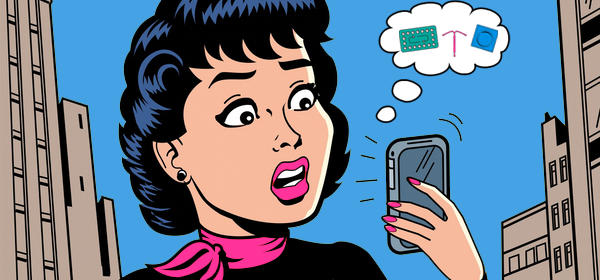


The truth is, we can't decide that for you, however we can provide the education to help you come to an informed decision. When it comes to IUDs there are both positive and negative things to say about each and every method available to you. Every woman is different so what you experience may not be the same experience as your friend, so remember your mileage may vary. Talk to your health care provider today and never worry about having to take a pill again.
Lets just dive into the negative. Every single woman worries about negative side effects, but for many women, they're not a problem. Once the IUD is in most women adjust pretty quickly. Some of the most common complaints are spotting between periods especially during the first few months after getting an IUD. Cramps and backaches and even increased period flow especially for those who choose the Paragard brand. Other things to look out for is infection, or your IUD slipping out. If you feel uncomfortable contact your health care provider immediately.
Now lets take a look at the positive. IUDs are easy to use, and there are actually a lot of good things about birth control that are good not just for your body but for the bedroom as well. The progestin IUDs may reduce cramps and make your period much lighter or go away, it's safe to use while breastfeeding, it's safe for smokers and thoses with hypertension or diabetes. The best part is it is long-lasting protection without much effort.
Some other great benefits of getting an IUD include no one can tell when you have an IUD. (Some partners say they can feel the strings, but no one else will know it's there.) There's no tell-tale packaging, and nothing you need to do just before you have sex. No packages or prescriptions to pick up at the pharmacy, so there's nothing that could get lost or forgotten.
Most experts agree, if you’re healthy and have a uterus, you’re probably a good candidate for the IUD. That’s true even if you are young and haven't ever been pregnant, or haven’t had kids yet. It’s also a great method for new moms (even if you’re breastfeeding).
You should return to fertility very quickly after you have the IUD removed. Which is great if you want to have a baby. But if you're not ready to get pregnant as soon as you have an IUD taken out, be sure to protect yourself with an alternate method.
and the best part If you're a busy person who does not want to have to worry about remembering birth control the IUD may be the choice for you. Once it has been placed by your health care provider, you're good to go for anywhere from 3 to 12 years.
Birth Control is not just a national problem; it's a global one as well - Click here to read about some of the global issues related family planning and birth control.
According to the Guttmacher Institute; Did you know?
The average woman spends about five years pregnant, postpartum or trying to become pregnant, and three decades trying to avoid an unintended pregnancy.
Currently, about half (51%) of the 6.6 million pregnancies in the United States
each year (3.4 million) are unintended
By age 45, more than half of all American women will have experienced an unintended pregnancy, and three in 10 will have had an abortion.
Unintended pregnancy rates are highest among poor and low-income women, women aged 18–24, cohabiting women and minority women.
The rate of unintended pregnancy among poor women (those with incomes at or below the federal poverty level) in 2008 was 137 per 1,000 women aged 15–44, more than five times the rate among women at the highest income level (26 per 1,000).
Poor women’s high rate of unintended pregnancy results in their also having high rates of both abortions (52 per 1,000) and unplanned births (70 per 1,000). In 2008, poor women had an unintended birth rate nearly six times as high as that of higher-income women (at or above 200% of poverty.)
In 2008, women without a high school degree had the highest unintended pregnancy rate among all educational levels (101 per 1,000 women aged 15–44), and rates were lower for women with more years of education.
Traditional estimates understate the extent to which sexually active teens experience unintended pregnancies, because they typically include all women, whether or not they are sexually active. The unintended pregnancy rate among only those teens who are sexually active is more than twice the rate among all women.[
Compared with higher-income women, poor and low-income women are less likely to end an unintended pregnancy by abortion. Consequently, poor women have a relatively high unintended birth rate.
In 2010, two-thirds (68%) of the 1.5 million unplanned births were paid for by public insurance programs, primarily Medicaid. In comparison, 51% of births overall and 38% of planned births were funded by these programs.
Of the 2.0 million publicly funded births, about half, 1 million, were unplanned. By comparison, 1.5 million out of 4.0 million total births nationwide were unplanned (38%).
The U.S. Department of Health and Human Services’ Healthy People 2020 campaign aims to reduce unintended pregnancy by 10%, from 49% of pregnancies to 44% of pregnancies, over the next 10 years.
Total public expenditures on unintended pregnancies nationwide were estimated to be $21.0 billion in 2010. Of that, $14.6 billion were federal expenditures and $6.4 billion were state expenditures.